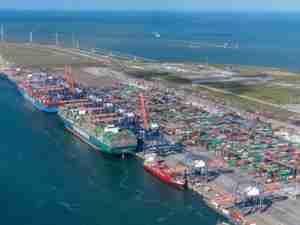- installing security cameras, access gate barriers and waterside intrusion detection at the cruise terminal;
- establishing a new access control center that creates better efficiencies for marine terminal entry points;
- implementing real-time video surveillance;
- becoming one of the first major U.S. ports to require the federally-mandated Transportation Workers Identification Credential (TWIC);
- installing a state-of-the-art entry system for trucks at the Dundalk Marine Terminal that includes: a gate pass system for cargo trucks, video cameras on the inbound and outbound lanes, and an intercom system between the truck lanes and a gate security building; and
- enhancing perimeter fencing and radiation portal monitors that check all containers leaving the Port by truck for radioactivity.
Coast Guard rates Port of Baltimore security ‘excellent’ for the sixth year in a row
posted by AJOT | Oct 24 2013 at 03:04 PM | Ports & Terminals
The Coast Guard Sector Baltimore praised the Maryland Port Administration (MPA) that manages the public marine terminals during the Coast Guard’s annual and comprehensive security exam for all of the Port’s public facilities: Dundalk, Seagirt, North Locust Point, South Locust Point (including the cruise passenger terminal), and Fairfield and Masonville marine terminals.
“The efforts MPA has made to renovate facilities while also establishing more effective security risk mitigation strategies has demonstrated your continued dedication to securing your facilities,” said U.S. Coast Guard Captain of the Port Kevin C. Keifer in a letter to MPA Executive Director James J. White. “Your staff’s proficiency and firm commitment to security at all of your port facilities led to a positive assessment of the United States from the European Commission.”
Accompanying the Coast Guard during this year’s inspection were representatives from the European Commission (EC), who were conducting a review of the United States’ enforcement of the International Ship and Port Facility Security Code. The Port of Baltimore was the first reciprocal visit under a Mutual Recognition Agreement between the U.S. and EC.
“Before our administration took office, security at the Port of Baltimore was not adequate,” said Governor O’Malley. “Thanks to our federal and state security partners, we have made tremendous strides in the last six years toward making the Port of Baltimore one of the most secure seaports in the nation. I congratulate all of our security professionals who work at the Port of Baltimore on this outstanding achievement and thank them for making Maryland citizens safer and more secure.”
Maryland’s congressional delegation has delivered $12 million in federal security grants since 2007. Thanks to the support of Team Maryland, the MPA has implemented many security improvements during the last few years with the federal security grants and the State’s matching funds, including
The Port of Baltimore is ranked as the top port among 360 U.S. ports for handling autos, farm and construction machinery, imported forest products, imported sugar, imported aluminum and imported gypsum. Baltimore ranks second in the U.S. for exported coal, and imported iron ore. Overall Baltimore is ranked ninth for the total dollar value of international cargo and 11th for international cargo tonnage.










